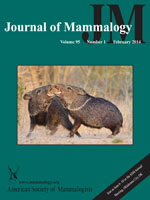Eurasian otters (Lutra lutra) have been described in the literature as solitary, with the 2 sexes interacting only during mating. Data on otter sociality are rather scant, however, especially in Mediterranean regions, and the group formation documented in temperate zones has suggested some social plasticity. We investigated the sociospatial organization of a Mediterranean population of Eurasian otters by analyzing static and dynamic interactions among 15 individuals radiotracked during 3.5 years in Alentejo (southern Portugal). Contrary to what is described in the literature and expected for solitary animals, otter dyads showed positive interactions, with individuals associating more often than expected by chance. Moreover, otter movement patterns were correlated. Finally, otters shared diurnal resting sites more often than expected. Adult males and females with cubs overlapped spatially and temporally, even sharing resting sites when the males had no paternity. Nonrelated otter dyads of opposite sex overlapped home ranges and core areas. Ranges of males overlapped with those of 1–3 females, whereas dyads of the same sex exhibited almost no overlap, confirming the classic mustelid intrasexual territoriality and a polygynous mating system (nevertheless, suspicions of female polyandry arose). On average, overlap of home ranges was higher than that of home-range cores. Our results contradict several statements in the literature on European otter sociality and reproductive behavior. We conclude that Eurasian otters are more social than previously thought, adding further evidence that social behavior in solitary carnivores may reveal significant flexibility.
How to translate text using browser tools
1 February 2014
Sociospatial organization of a solitary carnivore, the Eurasian otter ( Lutra lutra)
Lorenzo Quaglietta,
Vania C. Fonseca,
António Mira,
Luigi Boitani
ACCESS THE FULL ARTICLE

Journal of Mammalogy
Vol. 95 • No. 1
February 2014
Vol. 95 • No. 1
February 2014
dynamic interactions
home-range overlap
intrasexual territoriality
mating system
Mediterranean
radiotelemetry
resting site




